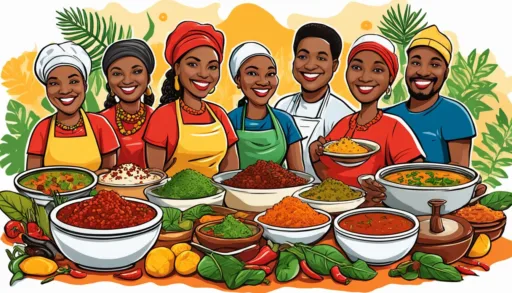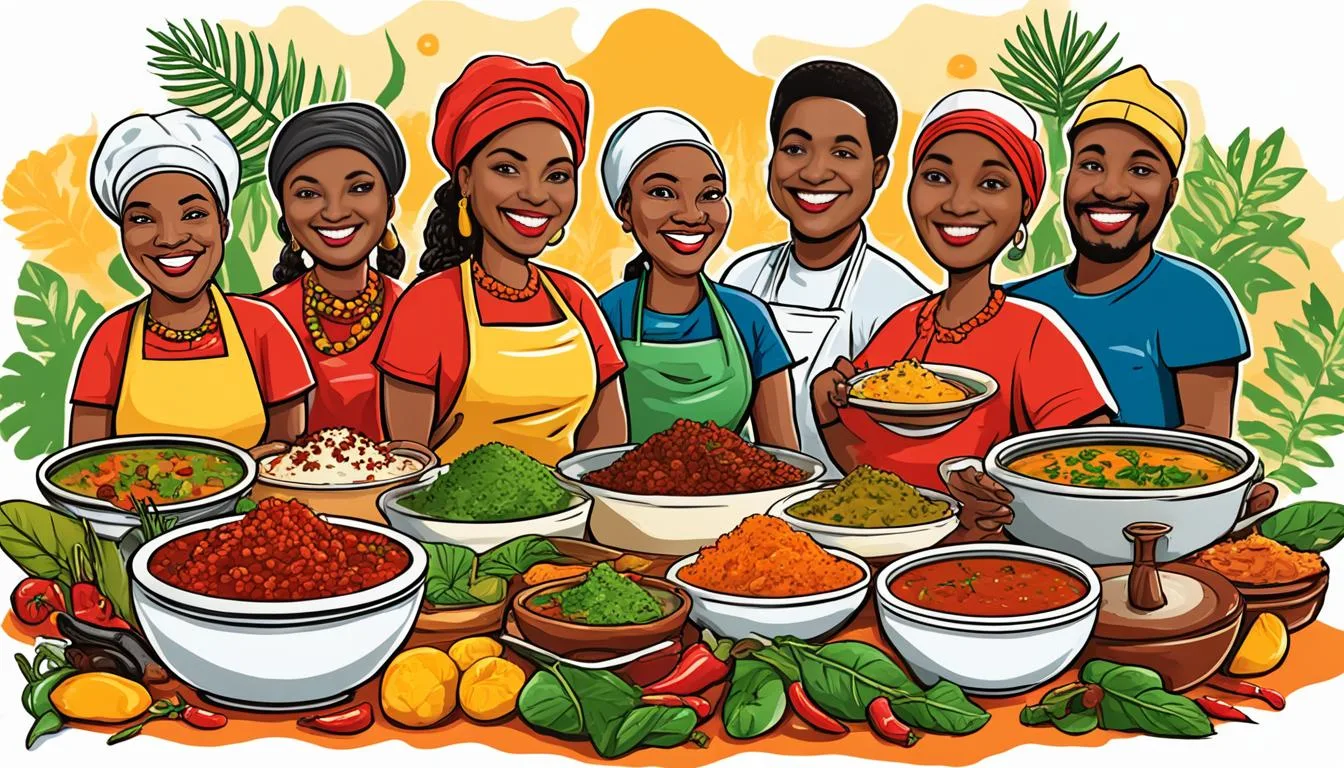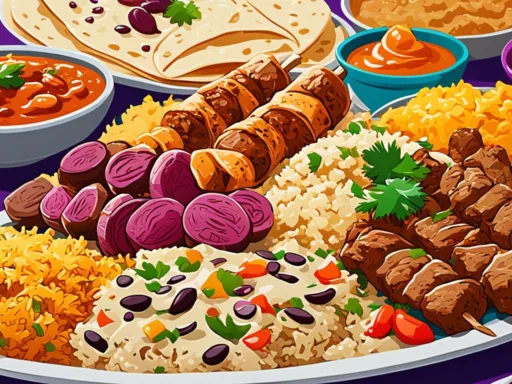Amidst the lush rainforests and sprawling coastlines, Liberia, a country the size of Tennessee, boasts a surprisingly multifaceted culinary scene. Despite its relatively small geographic footprint, the traditional dishes from Liberia offer an expansive taste landscape that is as rich as the country’s historical tapestry. This Liberian Cuisine Guide invites you to explore Liberian culinary traditions, where each meal tells a story of convergence and vibrancy — from the hearty Check Rice to the sweetly satisfying Kanyah, Liberia’s cuisine is a testament to the resilience and diversity of its people.
Food enthusiasts and intrepid travelers alike are drawn to this West African nation, eager to experience culinary history in the making. With a blending of indigenous practices and international influences, each dish offers a deeper understanding and appreciation for Liberia’s proud heritage. As we embark on this gastronomic journey, we’ll delve into the communal spirit of the dining traditions and the flavorsome fusions that make Liberian cuisine a hidden gem waiting to be discovered and savored.
Key Takeaways
- Liberian cuisine reflects a complex heritage of West African and European influences.
- Traditional dishes from Liberia, such as Check Rice and Jollof Rice, showcase the country’s rich culinary diversity.
- Key ingredients like cassava, plantains, and rice are staples in the Liberian diet, underscoring their importance in sustaining Liberian communities.
- Dining in Liberia is deeply rooted in community and sharing, highlighting traditions such as Country Chop.
- A journey through Liberian food culture is not just about tasting food, but also about experiencing the unity and warmth of its people.
- This guide offers an unprecedented opportunity to explore Liberian culinary traditions and savor the authentic flavors of this vibrant country.
The Historical Palette: Tracing Liberia’s Culinary Roots
Unearthing the essence of Liberian food culture reveals a tapestry woven with the vibrant threads of Liberian historical and cultural roots. Each dish tells a story, a narrative that has been shaped by centuries of history. It’s a legacy that has been handed down through generations, melding the diverse tastes of West African culinary crafts and European influences.
The country’s fertile land has long provided a bounty of crops that form the staple elements of Liberian cuisine. Traditional cooking methods bring out the unique flavors in native ingredients such as cassava, which is transformed into a variety of forms, from the staple ‘fufu’ to the much-loved ‘dumboy’. Plantains, another fundamental element, often find their way into dishes, either fried as a snack or served alongside stews.
Here’s a glimpse into how these traditional staples align with Liberia’s rich cultural ancestry:
| Ingredient | Historical Significance | Common Dishes |
|---|---|---|
| Rice | A symbol of sustenance, rice is deeply connected to Liberian heritage. | Jollof Rice, Palava Sauce |
| Cassava | Originally brought from Brazil, it’s now a symbol of adaptability and survival. | Cassava Leaf Soup, Fufu |
| Plantains | Harvested from lush forests, plantains reflect the abundance of Liberia’s land. | Kelewele, Plantain Chips |
| Fish | Fishing practices date back to Liberia’s earliest settlements. | Grilled Fish, Fish Soup |
Culinary customs such as communal eating continue to be a cornerstone of the Liberian lifestyle, showcasing the role of food as more than sustenance, but a means of fostering community and kinship. Shared meals emphasize the Liberian ethos of hospitality, where one is always welcome at the dinner table.
As we pay homage to the history of Liberian food culture, it becomes clear that the cuisine is an edible diary of the nation’s past – a rich history that continues to add flavor to every dish that graces a Liberian home.
An Introduction to the Liberian Cuisine Guide
Welcome to a delectable journey through the Liberian Cuisine Guide, a treasure trove brimming with authentic Liberian flavors and rich cultural stories. As you embark on this gastronomic adventure, prepare to be enveloped by the country’s captivating culinary narrative, one that harmoniously blends ancestral West African techniques with European and American influences.
The essence of Liberian cuisine is a symphony of flavors characterized by hearty stews, fragrant rice dishes, and an array of tropical fruits and vegetables. Through this guide, we’ll unveil the secrets behind staple Liberian meals, share insights on the optimal ways to savor these diverse dishes, and connect you with Liberia’s vibrant food culture and its communal dining philosophy.
Discovering Liberia’s culinary delights is much more than enjoying delicious food; it is an exploration of the country’s soul and a taste of its history.
- Explore the historical fusion that shapes today’s Liberian dishes.
- Learn about the fundamental ingredients that are the backbone of Liberian cooking.
- Uncover the intricacies of Liberia’s communal dining experiences.
The Liberian Cuisine Guide is more than a mere overview of recipes; it’s an invitation to grasp a deeper understanding of the country’s shared mealtimes and to celebrate the joy of eating together. Whether you’re a culinary explorer or a seasoned food lover, the knowledge you gain here will elevate your palate and provide you with the key to unlock the true flavors of Liberia. Let’s begin our culinary expedition.
The Staples of Liberian Cuisine: Rice, Cassava, and Plantains
Within the rich tapestry of Liberian staple foods, rice emerges as the quintessential element of daily sustenance. This versatile grain serves as a foundation for a myriad of traditional dishes from Liberia, each dish a testament to Liberian cooking techniques that have been honed over generations. The culinary scene in Liberia is also enriched by the extensive use of root crops like cassava and plantains, providing a solid base for a variety of cassava and plantain recipes that are integral to the Liberian diet.
Essential Grains: Rice in Liberian Daily Life
Rice – more than just a grain—is deeply woven into the fabric of Liberian culture. It is paired with a bountiful assortment of soups, stews, and sauces, reflecting the resourcefulness and creativity behind Liberian cooking practices. This essential grain occupies the central space on a Liberian dining table, underscoring its role beyond mere nourishment: it’s a unifying thread that binds together the families and communities of Liberia.
Roots and Tubers: Cassava and Plantain Recipes
While rice may take center stage, root and tuber crops like cassava and plantains play a supporting, yet vital role in the realm of Liberian cuisine. Cassava, transformable into various forms such as fufu or dumboy, bolsters many dishes with its starchy goodness, while the versatility of plantains can be experienced in both sweet and savory plates. These ingredients carve out their own niches, adding depth and flavor to traditional Liberian gastronomy.
| Ingredient | Description | Popular Dishes |
|---|---|---|
| Rice | A staple grain serving as a base for various meals | Jollof Rice, Palm Butter Soup with Rice |
| Cassava | A versatile tuber used in many forms | Cassava Leaf Stew, Dumboy, Fufu |
| Plantains | A robust fruit often featured in savory and sweet recipes | Plantain Chips, Fried Plantains, Kelewele |
Savoring Liberia’s Signature Dishes: Check Rice and Jollof Rice
When one talks about Liberian cuisine, the discussion wouldn’t be complete without the mention of the country’s signature dishes that have become synonymous with taste and tradition. Check Rice and Jollof Rice are not mere meals but a celebration of the Liberian palate, each encapsulating a rich tapestry of flavors and cooking techniques that are central to West African cultural identity.
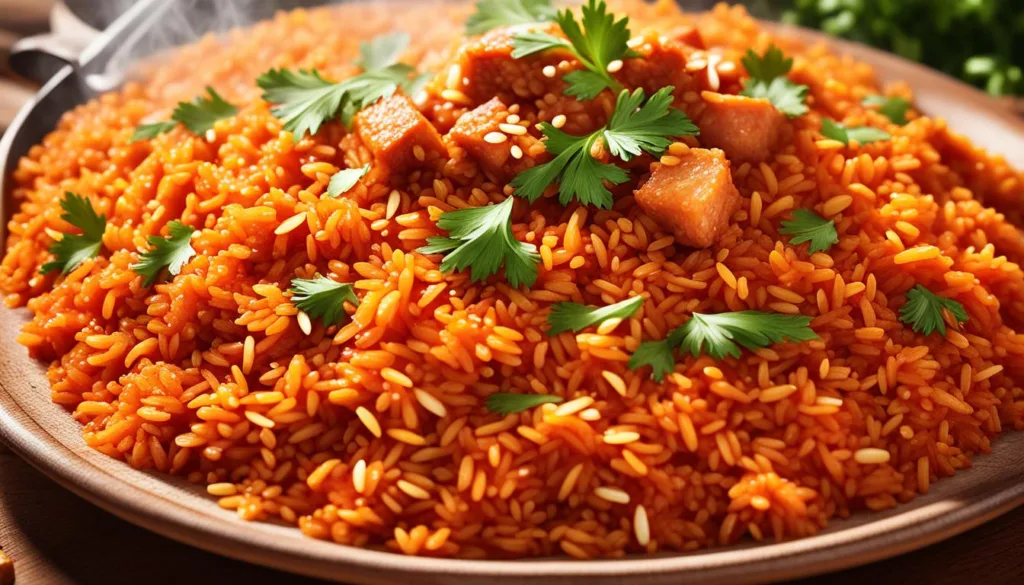
Check Rice, with its hearty base of parboiled rice, offers a canvas upon which the vibrancy of mixed vegetables and the richness of meat come together, accented by the distinctive flavor of Liberian palm oil. Derived from the palm nut, this oil is a cherished ingredient in many Liberian kitchens, lending its unique taste and reddish hue to the dish.
Jollof Rice, on the other hand, is a jubilant feast in itself. It’s crafted with a melody of tomatoes, onions, and peppers, married perfectly with rice that soaks up all the flavors. Often served at gatherings and special occasions, this dish represents the communal spirit of Liberian dining and has spread its culinary roots across West Africa.
| Feature | Check Rice | Jollof Rice |
|---|---|---|
| Main Ingredients | Rice, vegetables, meat, palm oil | Rice, tomatoes, onions, bell peppers |
| Flavor Profile | Savory with a hint of palm oil richness | Spicy and tangy tomato-based |
| Typical Occasion | Everyday family meals | Celebrations and social gatherings |
| Cooking Method | Stir-fried with ingredients and simmered | Simmered in a seasoned tomato sauce |
Both Check Rice and Jollof Rice are not just staples in a Liberian diet, they are a means through which one can taste the very essence of Liberian signature dishes. Each bite is a reminder of Liberia’s culinary prowess and the enduring legacy of its food culture.
A Taste of Sea and Land: Liberian Seafood and Meat Specialties
Indulge in the bounty of Liberia’s rich coastal waters and lush landscapes, where every meal narrates a tale of cultural heritage mingled with mouthwatering flavors. The coastal cuisine of Liberia wouldn’t be complete without a taste of its ocean treasures, while the Liberian meat specialties embody the country’s vast agricultural wealth and time-honored cooking practices.
Coastal Delights: Exploring Liberia’s Seafood Varieties
Liberian seafood is a testament to the country’s coastal gifts, offering up a delectable array of marine harvest. The local markets teem with fresh catches, and the traditional Liberian kitchen showcases methods that honor the natural tastes of the sea.
| Seafood Type | Preparation Method | Commonly Paired Spices | Served With |
|---|---|---|---|
| Grilled Tilapia | Char-grilled over an open flame | Liberian Pepper, Garlic | Rice and Spicy Pepper Sauce |
| Barracuda | Marinated and baked | Thyme, Ginger | Cassava |
| Prawns | Stir-fried or grilled | Lemon Pepper, Cilantro | Vegetable Medley |
| Lobster | Steamed with herbs | Old Bay Seasoning, Butter | Fresh Salad or Grilled Plantains |
From Land: Traditional Meat Preparation Techniques
The spotlight shifts from the sea to land, where Liberian meat specialties offer up savory sustenance. Drawing from a tradition steeped in history, these meat dishes incorporate flavors and techniques that are quintessentially Liberian.
- Smoking – Meats are delicately smoked over a delicately maintained flame, sealing in a unique, smoky flavor that is both robust and tender.
- Grilling – The grilling method imparts a charred exterior and a juicy interior, made perfect with the country’s vibrant mélange of spices.
- Stewing – Meat is slow-cooked to perfection, simmering in pots with a variety of indigenous herbs, spices, and vegetables, creating dishes that are rich and hearty.
The landscape of Liberian cuisine is as panoramic as its pristine beaches and rolling meadows. Whether you’re in the mood for the zesty zing of Liberian seafood or the comforting warmth of Liberian meat specialties, the country’s rustic kitchens and local eateries are a testament to the magical symphony of sea and land.
The Sweet Side of Liberia: Desserts and Sweets
Exploring Liberian cuisine reveals a world where succulent sweet Liberian treats form an essential part of the dining experience. The commitment to confectionary delight is exemplified by the popularity of Liberian desserts that range from street-side snacks to elaborate after-dinner sweets. One of the most treasured treats is ‘Kanyah,’ made from the simplest of ingredients yet delivering an irresistibly authentic flavor.
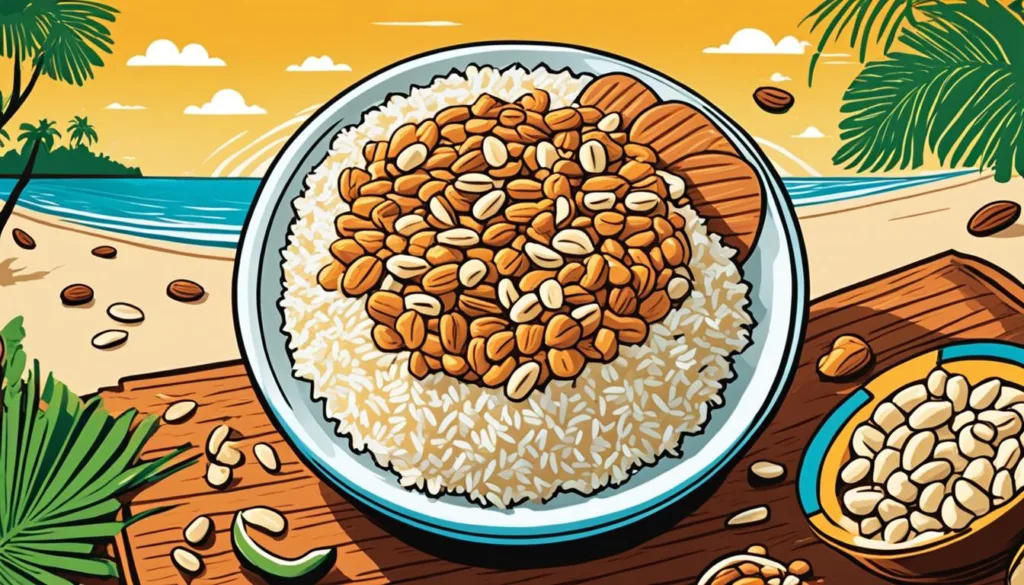
Kanyah, with its blend of finely ground peanuts, cane sugar, and rice turned into a flaky yet dense delight, has warmed the hearts of both locals and visitors alike. Its texture is just one element of its charm; the slightly smoky flavor from traditional roasting methods adds to its rich identity. Below is a comparative table illustrating some beloved Liberian dessert choices and their key characteristics:
| Dessert | Main Ingredients | Texture | Flavor Profile |
|---|---|---|---|
| Kanyah | Peanuts, sugar, rice flour | Crumbly | Sweet and nutty with a hint of smokiness |
| Ginger Cake | Ginger, molasses, flour | Moist and dense | Spicy and deeply sweet |
| Cassava Pone | Cassava, coconut, sugar | Firm pudding-like | Sweet with tropical coconut flavor |
| Plantain Balls | Plantains, sugar, spices | Soft and chewy | Sweet with warm spice notes |
These desserts are not just for individual indulgence but are often shared among friends and family, cementing their role in Liberia’s culinary tradition. Effortlessly captured in the care with which these sweet Liberian treats are prepared, is the essence of Liberia’s affectionate and communal spirit. Indeed, these Liberian desserts offer more than just a sweet finish to a meal; they are a vibrant part of the nation’s heritage and a delightful testament to its creativity and warmth.
Liberian Food Culture: A Community-Centered Experience
The essence of Liberian food culture lies in its communal dining traditions. In Liberia, a meal is more than just the consumption of food; it is a communal act that fosters unity, embodying the Liberian sharing tradition. These traditions permeate every aspect of Liberian dining, from ordinary family gatherings to grand communal feasts, celebrating the spirit of togetherness and hospitality that is deeply rooted in the nation’s culture.
The Significance of Communal Meals
In honoring these traditions, Liberian meals are often shared from a common bowl, encouraging interaction and conversation among diners. This way of eating is not merely practical but also symbolic, highlighting the importance of unity and equality in the community. The sharing of food is an intimate act that cements relationships and builds social ties, with each shared meal weaving a stronger social fabric.
Country Chop: A Celebration of Liberian Sharing Tradition
One of the most heartwarming examples of this shared dining philosophy is the ‘Country Chop’. This communal meal stands as a pillar of Liberian culture, where friends and family come together to contribute various dishes to a shared table. The ‘Country Chop’ is a lavish spread of the finest local cuisine, each dish telling a story of the individual or family who prepared it. The practice of sharing extends beyond food, as stories, laughter, and life experiences are exchanged, nurturing the bonds within the community.
| Country Chop Component | Description | Role in Communal Dining |
|---|---|---|
| Jollof Rice | Richly flavored one-pot rice dish | Unites diners over a shared favorite |
| Pepper Soup | Spicy, aromatic soup with meat or fish | Warms the gathering, inviting lively conversation |
| Cassava Leaves | Stew made from ground cassava leaves | Introduces traditional flavors, connecting diners to heritage |
| Fried Plantains | Sweet, caramelized side dish | Offers a comforting and familiar taste |
Each ‘Country Chop’ is a testament to the Liberian food culture, showcasing the joy of communal harmony and the vibrancy of shared culinary experiences.
The Vibrant Flavors of Liberian Street Food
Welcome to the bustling corners of Liberia, where the Liberian street food culture thrives, offering an array of flavors that reflect the nation’s love for hearty and portable meals. Sizzling grills, aromatic spices, and cheerful vendor calls are part and parcel of this vibrant scene. Here, popular Liberian recipes are not confined to the walls of a kitchen but spill out onto the streets, inviting locals and travelers alike to share in the culinary delights.

As you navigate through the lively markets and side streets, a world of taste sensations awaits. The humble kala—a fried dough ball made from rice flour—leaves a sweet and savory impression on your palette. Suya, skewered spicy meat, is a hit among those who favor a little heat, and grilled corn, with its smoky, buttery goodness, mesmerizes in its simplicity.
| Street Food | Main Ingredients | Taste Profile |
|---|---|---|
| Kala | Rice flour, sugar, water | Sweet, savory, crunchy |
| Suya | Beef or chicken, peanut spice rub | Spicy, smoky, meaty |
| Grilled Corn | Fresh corn, butter | Smoky, buttery, natural sweetness |
Not only do these street foods offer culinary enjoyment, but they also play a role in the everyday life of the Liberian people, serving as quick sustenance for busy urbanites and a source of income for countless vendors. Whether savored as a snack during a midday break or a casual dinner while perusing local crafts, Liberian street food is synonymous with the nation’s vibrant and communal way of life.
- Kala – A delightful snack for those on the go
- Suya – A favorite among meat-lovers seeking a quick spice fix
- Grilled Corn – A comforting treat that is both healthy and satisfying
What truly makes the Liberian street food experience remarkable is the fusion of indigenous cooking methods with a sprinkle of global flavors—a culinary tapestry attracting food lovers from different walks of life to confidently explore the authentic tastes of Liberia. So join in the celebration of flavor and community, where every bite tells a story of culinary craftsmanship and cultural pride.
Authentic Liberian Flavors: A Guide to Traditional Spices and Seasonings
Immersing oneself in the culinary delights of Liberia is incomplete without a deep dive into its rich palette of traditional spices and seasonings. These native ingredients form the backbone of authentic Liberian flavors, infusing every dish with distinctive aromas and tastes that are crucial to the authenticity of Liberian recipes.
Unlocking the Secret of Liberian Spice Blends
One cannot discuss Liberian spices and seasonings without mentioning the traditional blends that are a staple in homes and restaurants across the country. From the fiery kick of pepper sauce to the fragrant mix used in meat and fish dishes, these spice blends are paramount in capturing the essence of Liberian cuisine. Liberian cooks often utilize a cavalcade of spices such as country onions, bitter balls, and the much-celebrated ‘Pepper Sour.’ These spices are either used individually or combined into a potent blend that both complements and enhances the natural flavors of the ingredients.
The Role of Red Palm Oil in Liberian Cuisine
Red Palm Oil not only provides a uniquely vibrant hue to Liberian dishes but also introduces a depth of flavor that is instantly recognizable. This oil is extracted from the fruit of the oil palm and is a must-have in the pantries of those who are passionate about creating authentic Liberian recipes. Highly versatile, Red Palm Oil is the defining ingredient in dishes like palm butter soup and can enhance even the simplest rice side dish into an aromatic and visually appealing centerpiece of a meal. Its importance in Liberian cooking mirrors the broader West African culinary tradition, resonating with a shared cultural preference for full-bodied flavors and rich, satisfying meals.
Understanding the profound influence that these spices and Red Palm Oil have on Liberian culinary traditions underscores the nation’s gastronomic identity. Enthusiasts looking to recreate or experience genuine Liberian flavors should prioritize these critical elements, as they are the heartbeats of truly remarkable and soulful Liberian cooking.
Beyond the Plate: Drinks that Define Liberian Cuisine
Exploring the vibrant world of traditional Liberian drinks reveals a dimension of taste and tradition that complements the rich flavors of the country’s culinary scene. An integral part of the dining experience in the best Liberian restaurants, these beverages are essential to truly understanding Liberia’s gastronomic identity. To immerse oneself in Liberia’s drink culture is to acquire a taste for their history and societal norms.
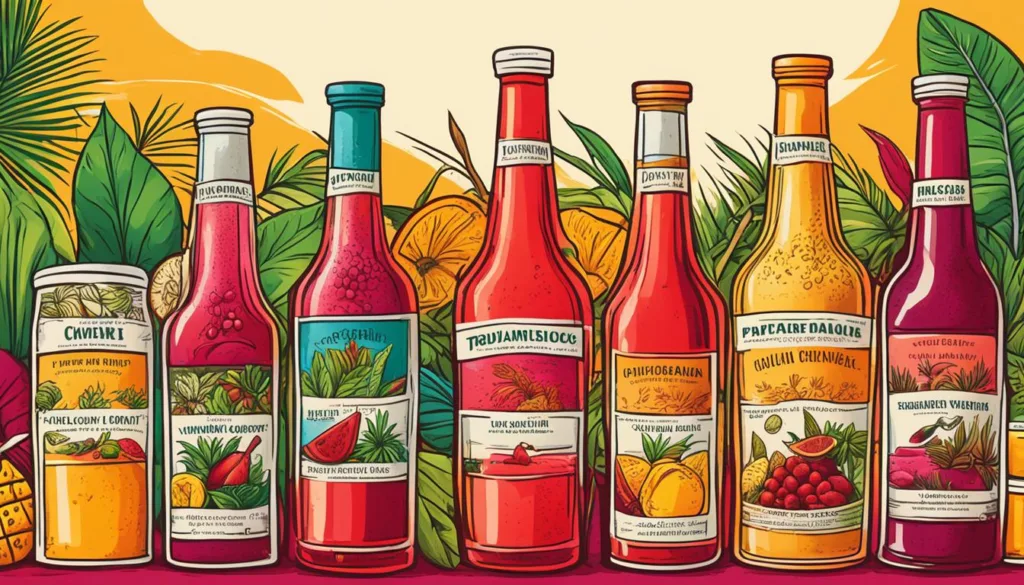
For many Liberians, Palm Wine holds a place of honor at the table. This mildly alcoholic beverage, tapped from the sap of palm trees, is enjoyed for its sweet, fermented taste that harbors a punch. Its significance is deeply rooted in Liberian social and ceremonial events, making it a staple at weddings, funerals, and communal gatherings.
On the non-alcoholic front, Ginger Beer stands as a beloved refreshment. Liberian Ginger Beer is characterized by its sharp yet refreshing kick, derived from the intense ginger root, sweetened with sugar and often mellowed with a squeeze of lemon juice. Authentic recipes of this zesty drink are passed down through generations, retaining their place in daily life and festive occasions.
- Palm Wine – A traditional alcoholic drink, native to Liberia’s culture and enjoyed across generations.
- Ginger Beer – A non-alcoholic beverage with a potent ginger taste, often homemade and cherished for its invigorating qualities.
As the Liberian palates enjoy these traditional drinks, the appreciation of their cultural significance deepens. When dining in the best Liberian restaurants, you’re likely to find these drinks paired wisely with meals, ensuring a holistic taste experience that resonates with the heartiness of Liberian cuisine. Whether it’s Palm Wine served with spicy grilled fish or Ginger Beer complementing a rich and hearty Country Chop, these drinks are integral to the full Liberian culinary adventure.
The Best Liberian Restaurants to Experience Authentic Cuisine
For gourmands seeking an authentic Liberian dining experience, the search for the ultimate meal ends at the best Liberian restaurants. These culinary gems provide a true taste of Liberia’s rich cultural heritage, serving traditional Liberian cuisine that is both flavorful and fulfilling. The following establishments, known for their traditional cooking methods and exclusive use of local ingredients, stand out as must-visit destinations for anyone craving genuine Liberian flavors.
Top Picks for Traditional Liberian Dining
Among the top picks for traditional dining is Evelyn’s Restaurant in Monrovia, renowned for its delectable ‘Palava Sauce’ and ‘Fufu’. Meanwhile, the cozy ambiance of The Golden Beach Restaurant in Buchanan allows diners to enjoy their ‘Grilled Barracuda’ against the backdrop of a picturesque sunset. Not to be missed, Martha’s Cookshop, also located in the heart of Monrovia, offers an extensive menu with classic dishes like ‘Cassava Leaf Stew’ and ‘Dumboy’.
Must-Visit Eateries for Travelers and Foodies
Travelers looking to dive into the culture of Liberia through its cuisine should note these must-visit eateries. Providence Island Cafe is a culinary stop not just for its food, but also for its historical significance, serving a variety of local seafood dishes. Foodies will appreciate the authenticity of traditional recipes at the trendy Mamba Point Hotel Restaurant, which is popular among locals and visitors alike. No culinary tour is complete without a visit to Atlantic Bar & Restaurant, where the Liberian Curry and Prawns are a treat for the taste buds.
In summary, those eager to encounter the best in traditional Liberian cuisine and authentic Liberian dining experiences will find these restaurants to be invaluable in their gastronomic journey through Liberia’s savory spectrum of flavors.
Conclusion
Our journey to explore Liberian culinary traditions unfolds a rich tapestry of community, history, and taste that is intricately woven into the fabric of their society. The diverse array of authentic Liberian flavors we’ve discovered attest to the country’s multifaceted cultural heritage and robust agricultural bounty. From the heaping plates of Check Rice and Jollof Rice to the communal spirit of Country Chop, we see that food in Liberia is as much a celebration of togetherness as it is of sustenance.
Liberian cuisine is underpinned by staple ingredients like rice, cassava, and plantains, forming the cornerstone of its gastronomic identity. Signature dishes, street foods, and sweet delights offer a window into the soul of Liberia, allowing us to savor each nuanced flavor. As we sipped on traditional Ginger Beer and Palm Wine, we toed the historic line of Liberia’s past, reveling in the beverages that define this nation’s culinary narrative.
In sum, to truly understand and appreciate Liberia, one must delve into its cuisine. This guide, a mere scratch on the surface of Liberia’s rich food culture, invites food enthusiasts and curious travelers alike to immerse themselves in the country’s hospitality and gastronomy. For in the act of preparing, sharing, and enjoying Liberian food lies a deeper understanding of this vibrant and resilient nation. So, we encourage you to continue this exploration, for every dish tells a story and every flavor leads to a new discovery.
